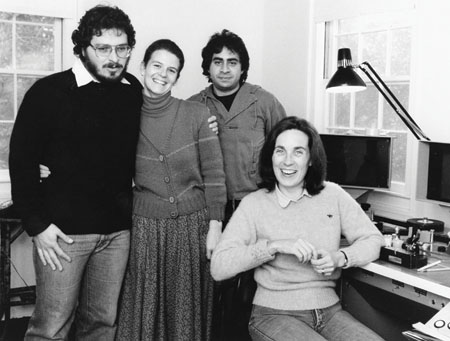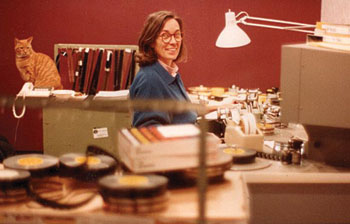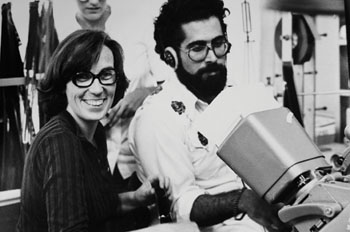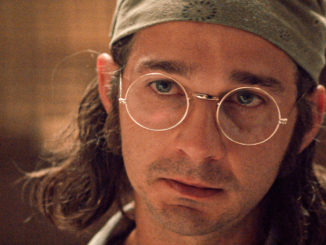
by Michael Mallory
Carol Littleton, ACE, has never been one to sit back and wait for something to happen. Instead, she makes things happen.
For example, as a novice film editor in the late 1970s, she did not wait around patiently, hoping for jobs to come her way. Rather, Littleton took charge of her career by forming her own commercial editing company.

Experiencing first-hand the difficulty of breaking into what was virtually a closed shop, she did not spend her time complaining about the status quo, but managed to join the Motion Picture Editors Guild and then ran for office, ultimately becoming President of the Guild in 1988––a position from which she led a “silent revolution” that changed the bylaws governing union eligibility and planted the seed for bringing together the Los Angeles and New York locals.
She has continued to serve the Guild and the industry in a variety of capacities on and off (mostly on) for two decades, including sitting on the Academy of Motion Picture Arts and Sciences’ Board of Governors.
Through it all, of course, Littleton has made her mark on the cinema. Her longtime collaboration with writer/director Lawrence Kasdan began in 1981 with Body Heat and continued for seven more films. The following year, Littleton was asked by Steven Spielberg to cut E.T.: The Extra-Terrestrial; her work on that film garnered nominations for an Academy Award, the British Academy of Film and Television Arts (BAFTA) Award and the American Cinema Editors (ACE) Eddie Award. More recently, a rare excursion into television for 1999’s Tuesdays with Morrie netted her an Emmy Award. Littleton took time out from her current project, The Rum Diary, to speak with CineMontage Magazine.
CineMontage: Your earliest credit was as a sound effects editor on Alan Rudolph’s Premonition. How did you move into picture editing?
Carol Littleton: After Premonition, I worked for two years for Richard Einfeld, an editor who had a very small sound facility that did dailies, transferring from quarter-inch to 35 or 16mm. I really wanted to be an editor at the time and Richard gave me my first opportunity. The first time I encountered an editing room, I knew editing was for me. I was a literature student and very interested in music––and editing somehow embodied all the things that I felt were my strengths.
But when I moved to LA in 1970, there were only two ways you could work in film until about 1980: either as a union or a non-union editor. There was no way to work on any Hollywood projects unless you were in the union, and practically the only way to get into the union was through nepotism. If you had a parent or an influential friend who happened to be an editor, it was very easy to join the Guild. But if you didn’t, the only way was to work at a company that signed a union contract.
A lot of younger editors don’t have the discipline that we had in film, where you really had to think about what you were doing before you started to edit. Now, with our digital tools, a lot of editors just start cutting and they don’t think about a plan ahead of time; they think it will evolve while they edit. It’s like being a writer and not having an outline before you start to write. You can see right away that’s not the way to write. Well, that’s not the way to edit either.
Right after I worked for Richard, I formed my own post-production company for commercials, because I saw that as the only way I was going to advance and learn the craft. One of my steady clients was a cameraman/director named Jerry Simms of Jerry Simms Productions. He signed a union contract, and because I had pay stubs that went through his company, I eventually got in the union. But there were still roadblocks, plenty of them.
Unfortunately, the group system of seniority kept newly minted members of the Guild from working. I was bumped off of lots of jobs because I didn’t have seniority. And too, I was discouraged by so many people: “The work is too competitive for a woman.” “Women will never work as long as men with families are looking for work.” “Why do you want to work in film when you already have a successful commercial company?” “You are setting yourself up for failure.” You have no idea how many established Hollywood editors told me: “Forget it.”
CM: Is that why you set out to change things for others?
CL: This plays very directly into how I got involved in the Guild. I didn’t want anybody to have to go through those hoops and confront what I did. There were two separate workforces––a non-union workforce of younger people like myself, who were getting their training however they could, and the old, entrenched Hollywood that was protected by the unions and the studio system. It was clear that the established system was falling apart. There was an emerging non-union work-force that was not only qualified, but also unbelievably talented. Our reforms started more or less when I became President and brought in my friends, people that had the same beef as I did.
CM: A lot of union disputes are very loud—SAG’s for instance—yet you call this one “a silent revolution.” How did you keep it silent?
CL: You have to realize that editors are quite different than actors. We are, by nature, listeners and negotiators. We negotiate what the director wants, what the producers want, and hopefully we are able to come out on the other side with a movie that is not only edited artistically, but also addresses the needs of everybody involved. We don’t particularly like to stir things up; that’s just our mindset. We got involved in this silent revolution because we really felt we could change the Guild from the inside, and that the quickest and the best way to fix it would be to change the rules and ultimately change our bylaws so that more people could be admitted based upon merit.

CM How did your association with Lawrence Kasdan begin?
CL: Larry had worked directly with George Lucas on The Empire Strikes Back, Return of the Jedi and Raiders of the Lost Ark, and George knew me because my husband [cinematographer John Bailey] and he had been in the same graduating class at USC. Plus, I had worked with Willard Huyck and Gloria Katz, who were close friends and collaborators with Lucas on French Postcards. This gave Larry the idea to call me. You know, sometimes you’re in the right place at the right time. I was lucky.
Larry gave me a copy of the script of Body Heat to read. Later, he told me that I was able to talk to him about it in a way that the other editors he had interviewed did not. Even more importantly, he felt that a woman would be able to cut the scenes that were more explicit in their sexual content in a more erotic way, making them more implicit. And that’s precisely what happened. We had several scenes that were very explicit, and together we refashioned them to make them more suggestive, more erotic. Others scenes landed on the cutting-room floor. Larry still has the lifted scenes, if you are interested!
CM: Is that initial meeting between you and the director a vital element of the job?
CL: The initial interview after you’ve read the script is probably the most important step, because not only does the director understand who you are, but you have an idea who the director is. After all, we spend a lot of time together in collaboration on the project. A case in point: I’m from rural Oklahoma and when I interviewed with Robert Benton for Places of the Heart, I knew right away the context of his film, Texas in 1936. I knew those people, their stoicism and dry, laconic humor. Benton and I had an instant simpatico relationship. Editors bring so much of their own experiences and tastes to their projects. Perhaps that is why we continue to love our work.
CM: You seem to move from very big studio films to very small independents, like In the Land of Women. How do you choose your projects?
CL: I don’t really care about the budget, how big or little it is. I really focus on the story, and if it’s a story and narrative that interests me, I want to do it. You’ll notice in my credits that I gravitate toward purely narrative films in the sense of strong screenplays, human dramas, rather than high-tech movies. I don’t edit films that have gratuitous violence. I like comedies, but I gravitate toward the ones in which the comedy stems from the characters as opposed to the situations in which they find themselves. I like stories where characters have very fixed ideas, where the humor comes from their unbending qualities, where the characters are self-contained and never step outside the story or are aware that they are “funny.” Some call these films “dramedies,” though I don’t like the term.
CM: How did you make the connection with Steven Spielberg for E.T.?
CL: It was through Larry Kasdan that my name came up. Steven was working on Raiders of the Lost Ark, which Larry wrote, during the time we were working on Body Heat. Steven told me, “A Boy’s Life–– E.T’s working title––is a little film that I want to do very quickly, and my longtime editor [Michael Kahn] is working on Poltergeist. I need someone good, and Larry said I should meet with you.” I went into his office at MGM to read the script on site. Afterwards, we talked, and he said he would get back to me on Thursday. On Thursday morning, he called and said, “Come in and talk to Wally [the unit production manager], and sign your start slip.”
CM: Did dealing with so many kids change the dynamic of shooting, and therefore the editing?
CL: It wasn’t the kids as much as it was E.T., the puppet. The kids were great and Steven is fantastic with children. He would engage them in games in between takes and relate to them like little people, not like little kids. They enjoyed the process, which was more like a game to them than work. The kids’ performances were not only engaging but also emotionally truthful and natural.
Our big concern was whether people would really believe in this little puppet or whether the first time they looked at it they would say, “Oh my God, that’s just a pile of rubber!” Most of our effort went into getting the puppet to work, not mechanically, but as a personality…how he reacted to and with the kids. When we shot one part of a scene, or one single motion, we’d shoot a whole magazine. Ten minutes of a hand movement to synchronize with a head movement, one gesture at a time. It was quite remarkable.

CM: You have worked with your husband, cinematographer John Bailey, on several occasions, including China Moon, which he directed. Is that different than working with someone who is not so close?
CL: It was very difficult, because there was no way to walk away from work, to get a fresh view. Emotionally, it was exhausting. Directors are on the firing line, and I felt that every blow to John was a blow to me. I realized I had to harden myself to that and not take things so personally on his behalf [laughter].
CM: You were among the first to really embrace the new digital technology for editing…
CL: We knew right away that if the Guild did not embrace the new technology, some editors would be left behind. The Guild adopted a training program to help make the transition from film to digital. A lot of editors and assistants did not want to retrain and learn a new system. A lot of the older editors simply dropped out of the business in the early ‘90s. When we started using the digital systems–– Lightworks and Avid–– there was a lot of resistance. Those of us who were more flexible and willing to adapt to the new technology have survived. Those who said, “I’m only going to work on film” had difficulty.
CM: Do you think the resistance was based in ideology?
CL: I rather suspect it was more like, “This is the way we’ve always done it and we’ve made good movies.” And they’re absolutely right. Who’s to say that Lawrence of Arabia would be a better movie if Anne Coates had edited it digitally? The Avid is a tool, and like all tools it can be misused. I am still a film editor at heart, although I work on an Avid. I think about what I want to do before I start to do it.
A lot of younger editors don’t have the discipline that we had in film, where you really had to think about what you were doing before you started to edit. The time and the physical effort it took to execute a scene was considerable.
You asked yourself a lot of questions before starting to edit. What is the dramatic intent of the scene? Where do I want to be in the scene? Who is reacting and who is acting? Where are the nuances? If there was a take where the actor was better in this part of the take, and there was another part that was better in take 10, and another part that was better in take 15, and another that was better in take 1, you thought about how you could weave all those pieces together to create a dramatically cohesive performance.
Now, with our digital tools, a lot of editors just start cutting and they don’t think about a plan ahead of time; they think it will evolve while they edit. It’s like being a writer and not having an outline before you start to write. You can see right away that’s not the way to write. Well, that’s not the way to edit either.
Another outcome of the digital technology is how films are shot. Directors used to weigh their choices and carefully plan the day’s work. Now, I refer to the fire-hose method of mise-en-scène where everything is shot with multiple cameras, never stopping until everything is wet. “Oh, we’ll figure it out in editorial.” This method of shooting is not cinema.
CM: How can a novice editor acquire the editorial mindset?
CL: I think that storytelling discipline comes from reading; being an analytical reader is the first step. If you can analyze the script and stick to the story, you will have a good take on the movie. Sam O’Steen, who’s one of my idols as an editor––though I didn’t really know him that well, I only met him on a couple of occasions––knew how to keep a story rolling. Another idol of mine, Hal Ashby, was a master editor. He knew that the emotional life on screen was delicate and had to be meticulously explored, that every element in storytelling worked in tandem.

Photo courtesy of Karen Arthur
CM: What do you look for in an assistant?
CL: I am very interested in an assistant who wants to be an editor, who wants to be a part of thinking about a film––in getting the story to work. I’m always looking for assistants who are really sharp and have the “editor gene” [laughter]. I’ve co-edited with many of my assistants, to give them a leg up, and almost all of them are editors now. Mia Goldman started as an apprentice and then went from apprentice to second assistant to first assistant. She was my co-editor on Silverado and is now a writer/director. Suzanne Spangler suffered 12 long years, working her way up the career ladder from apprentice to assistant and finally to editor with me on The Anniversary Party. Here are more past assistants who are now editors: Lisa Churgin, Jill Savitt, Barbara Tulliver, Norman Buckley, Gib Jaffe, Bruce Cannon, Raul Davalos and Marty Levenstein. I am probably forgetting someone and will hear about it!
CM: Do you ever see yourself moving up to director?
CL: No, no, I have no ambitions for that. My temperament is such that I get on a set and just go crazy. I prefer the calm, reflective sanctuary of the editing room.





